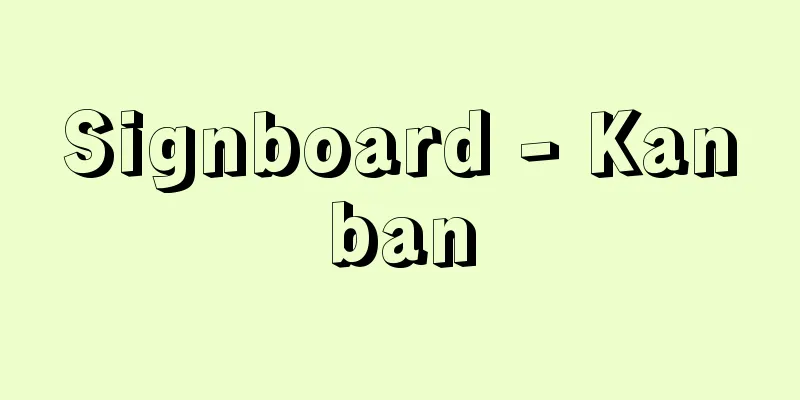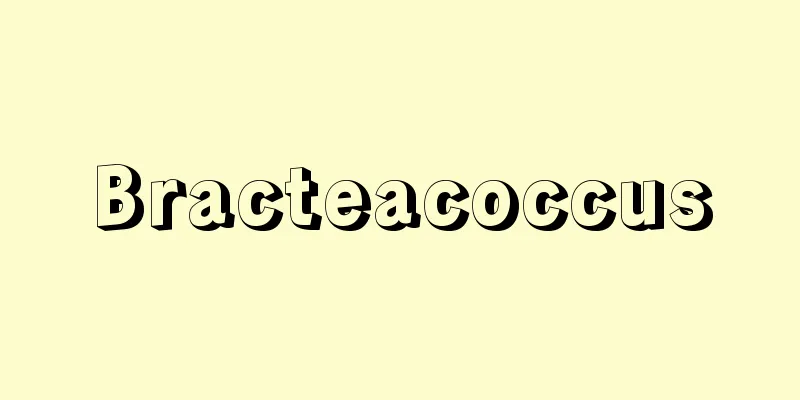Signboard - Kanban

|
A type of product advertising method in which the product, occupation or family name is represented in writing, pictures or models and hung as a sign in front of a store, on a eaves, on a pillar or on a roof. This has been around for a long time in both the East and West, and initially the product was simply displayed on a sign, but over time it became more elaborate, using letters and pictures. The origin of the signboard dates back to the early Heian period, when the "Ryo no Gige" states, "Set up a signboard in the fourth store and inscribe it with the name of the store." Signboards were set up in the markets on the east and west sides of the capital, as stipulated by law. However, in the market in Bizen Fukuoka depicted in the "Ippen Shonin Eden," nothing like this can be seen, with only goods lined up. This is the state of the market depicted in a picture scroll from the Kamakura period, but in literature, signs, or signs, can be seen along with store names from the end of the Muromachi period. In the following Azuchi-Momoyama period, small picture signs hung in front of stores along with noren curtains can be seen in the "Rakuchu Rakugaizu Byobu" and the "Shokunin Zukushie" in the Kitain Temple in Kawagoe, Saitama Prefecture. It was only in the Edo period that various kinds of signs became popular, as commerce developed and each store tried to make their products known and to attract customers, leading to fierce competition. At first, they were small and had a hill-shaped opening, but they gradually became larger, and it became fashionable to hang them on roofs so that they could be seen from afar. Before the Genroku period (1688-1704), most of the signs were small, but after the Kyoho period (1716-1736), there was a tendency for them to become larger. Signs were made of thick zelkova wood that would not rot even in the wind and rain, cedar boards painted with black lacquer and then pressed with gold and silver leaf, or decorated with makie (lacquer painting), and metal signs were made using copper and iron. Small, artistic works were also made to reflect the hobbies of the store owners. At the end of the Edo period, signs for gastrointestinal medicines, called "Uruyusu" (a decomposed character for "sky"), appeared. This is the Japanese name for the Dutch medicine ULUUS, a pun on the fact that taking it leaves your chest feeling refreshed, or "empty." The signs that were popular during the Edo period can be broadly divided into the following seven types: (1) Actual signs: These were often hung in front of stores to advertise the products on sale. These included hemp (ramie) stores, hat and umbrella stores, kamoji stores, gold leaf stores, raincoat stores, and paint stores. (2) Imitation signs When the product is small, it is enlarged to make it easier to recognize. A kiseru shop, a bag shop, a comb and hairpin shop, a tabi shop, a geta shop, an abacus shop, a fan shop, a hardware store, a book shop, a tobacco shop, a shogi shop, a greengrocer. (3) Items related to goods: Liquids, powders, etc. Liquor stores, oil stores, vinegar stores, tea leaf stores, etc., sell containers. Herbal medicine stores and sugar stores sell bags. Money exchange stores sell currency such as Kan'ei Tsūhō coins or Tenpō coins. Pawn shops sell broken pawn bills. (4) Puzzles. The comb shop's 94 or 194 combs (pickled combs), 13 or 23. The sweet potato shop's 13 ri, which is tastier than chestnuts (9 ri), is 8 ri and a half. The manju shop's horse ornament (arauma). The bath shop's actual bow with an arrow (yuiri). The amazake shop's Mikuniichi or a painting of Mt. Fuji (both made in a night). (5) Andon signboards: These are stores that are open not only during the day but also at night. Candle shops, soba and udon shops, restaurants, kabayaki restaurants, boat lodges, comedy halls, and theater teahouses. (6) Signs: Beniya, sushi shop, ice shop, fishing pond. (7) Signs with letters: Shoji screens and noren curtains are used. Hairdressers, rice shops, fish shops, izakayas, and restaurants serving a single meal. As the commercial economy developed, the number of businesses increased, and businesses naturally moved from sitting down to selling, and they were forced to make others aware of their products through powerful advertising. Signs gradually developed and diversified, and came to attract public attention. This trend rapidly increased in the Showa era with the influx of Western culture. Large painted signs became widespread, and then signs became unsatisfactory, so shops started to use ohiromeya (shops selling things at a pedestrian crossing) to distribute flyers. As times changed, businesses began to use airplanes, and even radio and television to keep track of their customers, and it seems that the era of noren and signs is gradually fading away. [Takeshi Endo] ChinaDuring the Tang Dynasty (7th century), a square or rectangular piece of cloth was hung from a pole in front of the gate as a sign for a liquor store. The square ones were called sake flags, and the rectangular ones were called sake bang or sake tang, but there are no records of signs before that time. This type of sign is still in use today, and can be seen in Japan at festival stalls, ice shops in the summer, and peddler's cars, and is considered the most simple type of sign. By the Song Dynasty (10th century), distribution systems had gradually become more established and more signs were seen. In the south, where the culture level was high, chaohai, a painted board with characters written on it, was widely used, while in the north, where the culture was low and few people could read and write, models of products or related items were displayed as signs, and were called wangzi. Later, signboards began to appear more frequently in the north, but these two styles remain elements of Chinese signboards today, and large signboards painted directly on the walls and fences of houses can still be seen. [Noh Sato] Europe and the United StatesThe oldest signs found in the ruins of Pompeii, which was buried in 79, include a dairy shop with a bisque-glazed red clay relief of a goat hanging in front of its storefront, and a liquor store sign with two men carrying wine jars on a pole, but nothing is known about signs in ancient Egypt or Greece. In Roman times, taverns displayed ivy branches as signs in front of their stores, which is said to have originated from the use of ivy in the festival of Bacchus, the god of wine. In England, taverns and inns also displayed these signs, and even today, ivy-decorated liquor store signs can be found all over Europe. A sign with a design similar to the Pompeii relief, showing two men carrying a large bunch of grapes on a pole, can be found in the Champagne region of France, and in this region, where alcohol brewing is thriving, there are many signs decorated with grape bunches and branches, as well as wine barrels, wine bottles, and wine cups. In ancient and medieval times, inns were chosen based on the status of the guests, and they would display a symbol indicating their status on their eaves: a cross for Christians, a star or sun for pagans, or a weapon for soldiers. This custom spread to ordinary shops, and they started to display signs in front of their stores that specifically represented the items they sold: shoes at shoe stores, sheep or spinning wheels at wool stores, ploughs at farm tool stores, knives at cutlery stores, scissors at tailors, etc. Some signs have special meanings, such as the three golden balls at pawn shops and the red and white striped poles at barber shops. The golden balls were used by pawn shops that worship Saint Nicholas as their patron deity, based on the story that Saint Nicholas gave three virgins a bag full of gold as wedding money. Another theory is that the ancestors of a family that opened pawn shops and banks in London were in the medical business and used the three golden balls, representing pills, as their coat of arms, and so they used these as the symbol of pawn shops. In the past, barbers also worked as surgeons, so the dandara stick was said to have been made to look like a bloodstained arm wrapped in white bandages, but nowadays, the red, white and blue are used to create a more decorative effect, and the red is interpreted as arteries and the blue as veins, making it an international sign for barbershops. Following the example of the identification signs posted at inns, general stores also used signs related to their religions to attract the attention of Christians and non-believers, but as the number of barbers increased and fewer people could read, they began to use pictures to represent their names or to use their own unique signs, and these signs were also used as directional and navigation markers. In the 16th and 17th centuries, more elaborate signs appeared to attract people's attention, and there was a competition to make the biggest sign possible, so in big cities such as London and Paris, laws were passed to limit the size of signs and to prohibit them from being placed on roads, requiring them to be placed close to walls. At the end of the 18th century, lights began to be used as signs for shops that were open at night, and the number of people who could read gradually increased, and by the 19th century signs with the shop name written on them began to appear. In America, reflecting the development of roads and the vastness of the country, huge billboards can be seen everywhere along the roads. Generally, they can be divided into two types: classical European style and pop art style with a strong commercial appeal, and each state has its own characteristics. In the eastern New England, there are many British-style board signs, while in the sunny southern Florida region, there are many signs with light touches and bright colors, and in New Orleans, which was once occupied by France, there are many stylish signs with strong French influences and signs using French words. In the west, there are many designs reminiscent of the pioneer era, such as cowboy dolls, horse-drawn carriages, and oxen, but the wedding chapel signs commonly seen in Las Vegas include one that reads "Weddings available 24 hours a day," and the system is that couples stay for six weeks, obtain citizenship, then go through divorce proceedings and can get married again right away. [Noh Sato] "Illustrated Guide to Edo Signs" by Hayashi Yoshikazu (1978, Miki Shobo)" ▽ "Illustrated History of the Evolution of Advertising in Japan" by Endo Takeshi (1961, Chunichi Shimbun)" ▽ "European Signs 1 and 2" by Mukaida Naoki (1979, 1982, Bijutsu Shuppansha)" ▽ "American Signs" by Mukaida Naoki (1981, Bijutsu Shuppansha) [Reference] | |Source: Shogakukan Encyclopedia Nipponica About Encyclopedia Nipponica Information | Legend |
|
商品広告方法の一種で、商品、職業や家名を、文字、絵画あるいはその模型などに表し、店頭、軒先、柱、屋根上に掲げて標識としたもの。東西ともに古くからあり、最初は商品をそのまま示して看板にしていたが、しだいに文字や絵を使って趣向を凝らしたものになった。 看板の起源は平安時代初期の『令義解(りょうのぎげ)』に「肆廛(みせ)に榜標(ぼうひょう)を立て行名(こうめい)を題せよ」とあるように、法令で決められ、都の東西の市(いち)に立てたものであった。しかしながら『一遍上人絵伝(いっぺんしょうにんえでん)』に描かれた備前(びぜん)福岡の市には、それらしきものはみられず、商品だけが並べられている。これは鎌倉時代の絵巻物に描かれた市のありさまであるが、文献的には室町時代の末期から屋号とともに標識、つまり看板がみられる。次の安土(あづち)桃山時代に入ると、のれんとともに店先に掲げられた小さな絵看板が『洛中洛外図屏風(らくちゅうらくがいずびょうぶ)』や埼玉県川越(かわごえ)市喜多院所蔵の『職人尽絵』のなかにみられる。いろいろの看板が盛んに行われるようになったのは江戸時代に入ってからで、商業が発達し、各店舗がそれぞれ自家の商品を認識させ購買意欲を誘い合い、競争が激しくなったためである。最初は小さな入り山形をしたものであったが、しだいに大形化し、これに加えて遠方からでも展望できるように、屋根の上へ掲げることが流行していった。元禄(げんろく)時代(1688~1704)以前は小さなものが多く、享保(きょうほう)(1716~36)以降になると大形化してゆく傾向がみられる。風雨にあっても腐らないケヤキの分厚いものを用いたり、スギ板に黒漆を塗ってそれに金銀箔(はく)を押したり、蒔絵(まきえ)を施したり、銅、鉄を利用して金属製の看板もつくられた。また店舗の主人の趣味を生かした、小ぶりで芸術的な作品がつくられることもあった。江戸末期になると胃腸薬の看板「ウルユス」(空の分解字)が現れた。これはオランダ舶来の薬ULUUSの和名で、これを飲むと胸がスーッとする、つまり「空(から)」になるという洒落(しゃれ)である。 江戸時代に盛行した看板を大別してみると、次の7種類に分類される。 (1)実物看板 多く店頭に掲げて販売品を知らせたもの。麻(麻苧(まお))屋、笠(かさ)・傘屋、かもじ屋、金箔屋、合羽(かっぱ)屋、絵の具屋。 (2)模造看板 商品が小さいときに拡大して認識させる。きせる屋、袋物屋、櫛(くし)・笄(こうがい)屋、足袋(たび)屋、下駄屋、そろばん屋、扇屋、金物道具屋、帳面屋、煙草(たばこ)屋、将棋(しょうぎ)屋、八百屋。 (3)商品と関係ある物 水物、粉物などの類。酒屋、油屋、酢屋、葉茶屋(お茶の葉を売る店)などはその容器。生薬(きぐすり)屋、砂糖屋は袋物。銭両替(ぜにりょうがえ)屋は寛永通宝(かんえいつうほう)あるいは天保銭(てんぽうせん)など貨幣。質屋は質札の反故(ほご)。 (4)判じ物 櫛屋の九四(くし)あるいは十九四(とくし)(すき櫛)の十三屋、二十三屋。焼きいも屋の九里四里(くりより)うまい十三里、その味は栗(くり)(九里)に近しの八里半。饅頭(まんじゅう)屋の馬の置物(あら甘(うま)し〈駻馬(あらうま)〉)。風呂(ふろ)屋の弓に矢をつがえた実物(湯入る)。甘酒屋の三国一または富士山の絵(ともに一夜でできた意)。 (5)行灯(あんどん)看板 商売は昼間ばかりでなく夜間でも営業する店舗。ろうそく屋、そば・うどん屋、料理茶屋、蒲焼(かばや)き屋、船宿、寄席(よせ)、芝居茶屋。 (6)幟(のぼり)看板 紅屋、すし屋、氷屋、釣り堀。 (7)文字看板 障子や「のれん」を利用する。髪結い床、米屋、魚屋、居酒屋、一膳飯(いちぜんめし)屋。 看板は、商業経済の発達につれて同業が増え、当然のことながら座して売ることから、強力なる宣伝によって自家商品を他人に認識させる必要に迫られ、漸次発展多様化し、世人の注目を浴びることとなった。この傾向は欧米文化の流入によって昭和に入ると急速に高まった。ペンキ塗りの大看板がはびこり、さらには看板ではもの足りなくなって、東西屋(おひろめ屋)を利用し、ビラをまいたりした。時代の変化につれ飛行機を利用したり、さらにラジオやテレビを利用して顧客の把握に努めているのが現況で、のれん、看板の時代はしだいに遠のいていく観が強い。 [遠藤 武] 中国唐代(7世紀)には、酒店の標識として四角あるいは長方形の布片を竿(さお)の先に下げて門前に立てた。四角のものは酒旗、長方形のものは酒旆(しゅはい)または酒帘(しゅれん)とよばれたが、それ以前には看板らしきものの記録はない。この形式のものは現在も用いられており、日本でも縁日の出店や夏季の氷店あるいは行商の車などにみられ、もっとも素朴な看板といえる。宋(そう)代(10世紀)になると流通機構もしだいに整って看板も多くみられるようになり、文化水準の高い南方では板に彩色をして文字を記した招牌(チャオハイ)が多く用いられ、文化が低く文字を解する者の少ない北方では商品の模型やこれに関係のあるものを掲げて標識とし、望子(ワンズ)とよばれた。のちに北方でも招牌が多くみられるようになったが、この二つの様式は現在も中国の看板の要素となっており、家屋の壁や塀に直接描いた大きな招牌も多くみられる。 [佐藤農人] 欧米もっとも古いものとしては、赤土で素焼きにしたヤギのレリーフを店頭に掲げた乳屋や、2人の男性が棒に吊(つ)るした酒壺(さけつぼ)を担いでいる酒屋の看板などが、79年に埋没したポンペイの遺跡にみられるが、古代エジプトやギリシアの看板についてはさだかでない。ローマ時代の居酒屋はキヅタの枝を店頭に掲げて標識としたが、酒神バッカスの祭礼にキヅタを用いたところからといわれ、イギリスでは居酒屋を兼ねた旅宿がこれを掲げ、現在もキヅタをあしらった酒店の看板はヨーロッパ各地にみられる。ポンペイのレリーフに似たデザインで、棒に吊るした大きなブドウの果房を2人の男性が担いでいる看板がフランスのシャンパーニュ地方にみられるが、酒造りの盛んなこの地方には酒樽(さかだる)や酒瓶、酒杯などのほか、ブドウの果房や枝葉をあしらった看板は数多い。古代・中世では宿泊者の身分によって旅宿が決まっており、キリスト教徒の場合は十字架、異教徒の場合は星または太陽、軍人の場合は武器というように、宿泊者の身分を表すしるしを軒先に掲げた。 この風習が一般の商店にも及んで、商う物を具体的に表す標識を店頭に掲げるようになり、靴店では靴、毛糸店では羊または糸繰り車、農具店では犂(すき)、刃物店ではナイフ、仕立店では鋏(はさみ)などを用いた。なかには質店の3個の黄金色の玉や理髪店の赤白のだんだら棒などのように特殊ないわれをもつ標識もある。黄金色の玉は、聖ニコラスが3人の処女に結婚の費用として黄金の入った袋を与えたという故事から、聖ニコラスを守護神とする質店が用いたとも、ロンドンで質店や銀行を開いた一族の祖先が医薬を業としていて丸薬を表す3個の黄金の玉を紋章としたので、これを質店の目印にしたともいう。だんだら棒は、昔は理髪師が外科医を兼ねていたので血に染まった腕に白い包帯を巻いた形を標識にしたといわれ、現在は赤白に青を加えて装飾的効果を著しくするとともに、赤は動脈、青は静脈と解釈されて理髪店の国際的な標識となっている。旅宿に掲げられた身分識別のためのしるしに倣い、一般商店でもキリスト教徒や異教徒の注意をひくために、それぞれの宗教に関係のあるものを用いたりしたが、やがて同業者が増えるに伴い、文字を解する者が少ないので、各自の姓名を絵で表したり、それぞれ独特な標識を用いるようになり、これらの看板は方角や道案内の目印にもされた。16、17世紀にはいっそう人々の関心をひく趣向を凝らした看板が現れ、大きさを競うに至ったので、ロンドンやパリなどの大都市では、大きさを制限したり道路上への設置を禁止して壁に密着させるようにする法律ができたりした。18世紀末には夜間営業の店の看板に灯火を用いるようになり、文字の読める者もしだいに増えて、19世紀には店名を書いた看板がみられるようになった。 アメリカでは自動車道路の発達と広大な土地を反映して、路傍の至る所に巨大な看板がみられるが、一般的にはヨーロッパ風のクラシックなものと、ポップ・アート風の商業性の強いものとに分けられ、また州によってそれぞれ特徴がある。東部のニュー・イングランドにはイギリス風の板絵の看板が多くみられ、陽光に恵まれた南部のフロリダ地方には明るい色彩の軽快なタッチのものが多く、かつてフランスが領有したニュー・オーリンズにはフランスの影響を強く受けたしゃれた看板やフランス語を用いたものも多くみられる。西部にはカウボーイの人形をはじめ幌(ほろ)馬車や牛馬など開拓時代をしのばせるデザインのものが多いが、ラス・ベガスで多くみかけるウェディング・チャペルの看板には「24時間いつでも挙式する」と記されたものがあり、6週間滞在して市民権を得たのち離婚手続をとり、またすぐ次の結婚ができる仕組みになっている。 [佐藤農人] 『林美一著『江戸看板図譜』(1978・三樹書房)』▽『遠藤武著『図説日本広告変遷史』(1961・中日新聞社)』▽『向田直幹著『ヨーロッパの看板1・2』(1979、82・美術出版社)』▽『向田直幹著『アメリカの看板』(1981・美術出版社)』 [参照項目] | |出典 小学館 日本大百科全書(ニッポニカ)日本大百科全書(ニッポニカ)について 情報 | 凡例 |
>>: Kanban - Kanban (English spelling) Guðmundur Kamban
Recommend
Sports - Sports (English spelling)
"Sports is a culture common to all of humani...
Spanish Civil War
An armed rebellion against the Spanish Popular Fro...
Arabiya - Arabiya
…It belongs to the South Semitic branch of the Se...
selenium
Se. Atomic number 34. Electron configuration [Ar]...
Caligo
…General term for insects belonging to the Brasso...
Tsutomu Ema
1884-1979 A historian of manners and customs from...
Triangular Trade
Generally, it is a type of multilateral trade, a m...
Praetor (English spelling)
One of the senior magistrates of ancient Rome. It ...
Shanghai
It is the largest city in China, located in the e...
Electrical machinery industry
This is an industry that manufactures equipment re...
Breton language - Breton (English spelling)
A language spoken by approximately 500,000 to 900,...
n-nuclear complex
...Complexes that have one central atom are usual...
Mongkut (English spelling)
1804‐68 The fourth king of the current Rattanakosi...
Rhyton (English spelling)
A type of ancient drinking tableware. It is a horn...
Cooper
Scottish chemist. After studying humanities and c...

![Guaytecas [island] - Guaytecas](/upload/images/67d07d07d247d.webp)







